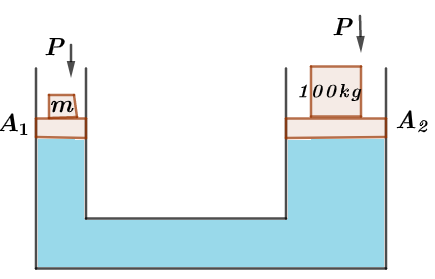
A hydraulic press can lift $100kg$ when a mass ‘m’ is placed on the smaller piston. It can lift _______ kg when the diameter of the larger piston is increased by $4$ times and that of the smaller piston is decreased by $4$ times keeping the same mass ‘m’ on the smaller piston.
Answer
222.9k+ views
Hint: In order to solve this question, we will apply Pascal’s law for equal liquid levels for a given hydraulic press and then we will form an equation in terms of mass m and area A to find the final value of lifting mass when the diameters of the piston are changed.
Formula used:
Pascal’ law for equal water level is represented mathematically as:
$P + \dfrac{{mg}}{A} = P' + \dfrac{{m'g}}{{A'}}$
Where, P represent pressure, m is mass, g is gravity and A is the area of piston.
Complete answer:
Let us first draw the rough diagram representing a smaller piston and larger piston of area ${A_1},{A_2}$ and $P$ is the atmospheric pressure acting on both pistons at same liquid level and m is the mass is on smaller piston when it can lift mass of
$100kg$ on larger piston as

Applying Pascal law for both piston for this initial case we get,
$
P + \dfrac{{mg}}{{{A_1}}} = P + \dfrac{{100g}}{{{A_2}}} \\
\dfrac{m}{{{A_1}}} = \dfrac{{100}}{{{A_2}}} \to (i) \\
$
Now, Diameter of larger piston is increased by four times so new area A’ will be $A' = 16{A_2}$ similarly, diameter of smaller piston is decreased by four times so new area A’’ will be $A'' = \dfrac{{{A_1}}}{{16}}$
Now, again applying Pascal’s law for unknown lift mass M on a larger piston we get,
$\dfrac{m}{{A''}} = \dfrac{M}{{A'}}$ on putting the values from equation (i) we get,
$
\dfrac{{16(100){A_1}}}{{{A_1}({A_2})}} = \dfrac{M}{{16{A_2}}} \\
M = 25600Kg \\
$
Hence, now the larger piston can lift the mass of $25600kg$.
Note:It should be remembered that the area of a circle is directly proportional to the square of the diameter of the circle and here pistons are supposed to be circular which are generally made circular in the practical hydraulic press also.
Formula used:
Pascal’ law for equal water level is represented mathematically as:
$P + \dfrac{{mg}}{A} = P' + \dfrac{{m'g}}{{A'}}$
Where, P represent pressure, m is mass, g is gravity and A is the area of piston.
Complete answer:
Let us first draw the rough diagram representing a smaller piston and larger piston of area ${A_1},{A_2}$ and $P$ is the atmospheric pressure acting on both pistons at same liquid level and m is the mass is on smaller piston when it can lift mass of
$100kg$ on larger piston as

Applying Pascal law for both piston for this initial case we get,
$
P + \dfrac{{mg}}{{{A_1}}} = P + \dfrac{{100g}}{{{A_2}}} \\
\dfrac{m}{{{A_1}}} = \dfrac{{100}}{{{A_2}}} \to (i) \\
$
Now, Diameter of larger piston is increased by four times so new area A’ will be $A' = 16{A_2}$ similarly, diameter of smaller piston is decreased by four times so new area A’’ will be $A'' = \dfrac{{{A_1}}}{{16}}$
Now, again applying Pascal’s law for unknown lift mass M on a larger piston we get,
$\dfrac{m}{{A''}} = \dfrac{M}{{A'}}$ on putting the values from equation (i) we get,
$
\dfrac{{16(100){A_1}}}{{{A_1}({A_2})}} = \dfrac{M}{{16{A_2}}} \\
M = 25600Kg \\
$
Hence, now the larger piston can lift the mass of $25600kg$.
Note:It should be remembered that the area of a circle is directly proportional to the square of the diameter of the circle and here pistons are supposed to be circular which are generally made circular in the practical hydraulic press also.
Recently Updated Pages
JEE General Topics in Chemistry Important Concepts and Tips

JEE Extractive Metallurgy Important Concepts and Tips for Exam Preparation

JEE Atomic Structure and Chemical Bonding important Concepts and Tips

JEE Amino Acids and Peptides Important Concepts and Tips for Exam Preparation

Electricity and Magnetism Explained: Key Concepts & Applications

JEE Energetics Important Concepts and Tips for Exam Preparation

Trending doubts
JEE Main 2026: Application Form Open, Exam Dates, Syllabus, Eligibility & Question Papers

Derivation of Equation of Trajectory Explained for Students

Hybridisation in Chemistry – Concept, Types & Applications

Understanding the Angle of Deviation in a Prism

How to Convert a Galvanometer into an Ammeter or Voltmeter

Degree of Dissociation: Meaning, Formula, Calculation & Uses

Other Pages
JEE Advanced Marks vs Ranks 2025: Understanding Category-wise Qualifying Marks and Previous Year Cut-offs

Dual Nature of Radiation and Matter Class 12 Physics Chapter 11 CBSE Notes - 2025-26

Ideal and Non-Ideal Solutions Explained for Class 12 Chemistry

Understanding the Electric Field of a Uniformly Charged Ring

Understanding Atomic Structure for Beginners

Understanding Electromagnetic Waves and Their Importance




